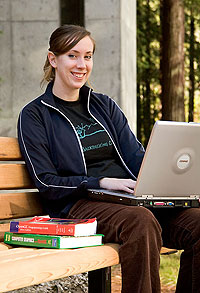December 12, 2005
Growing usage drives efforts to upgrade campus wireless Internet system
By Guy Lasnier
Wireless computing has taken the campus by storm. So much so that big changes are hoped for next year.

Kathleen Tuite, a junior in computer science, takes advantage of a wireless hot spot on campus.
Photo: Jim MacKenzie |
This Saturday morning technicians from Information Technology Services will shut the system down for two hours to complete some minor upgrades to improve service reliability. More extensive upgrades are in the planning stages with a target of midsummer or fall for completion, although funding remains an issue.
CruzNet, the wireless Internet access system at UCSC, has been up for a bit more than two years. It went live campuswide in September 2003 with 160 access points. More were added in early 2004. CruzNet allows computer users across campus to connect wirelessly with the Internet and has proven extremely popular.
Demand has been increasing, with students, staff, and faculty wanting more wireless access points in more areas, said Frank Koch III, ITS network tech supervisor, project manager for the original rollout.
Usage has “grown tremendously,” Koch said.
The initial installation was funded with a one-time grant of $500,000, said Richard Chew, network services manager. Chew said ITS will be seeking funding to expand and upgrade.
In 2003, about 100 users might have been logged on at one time, Koch said. That number has ballooned to 1,058 users at any one time today, he said.
“We built a lot of growth potential into it, anticipated a lot of usage,” Koch said.
Now, the growth in usage and demand for more access is driving efforts to upgrade the system. Also, as technology advances, new equipment will allow for faster service and more security. Increasing system security is a goal, Chew said.
Koch said there are now 223 access points on campus --essentially radio transmitters that send and receive radio waves from personal computers outfitted with the proper gear. Today’s laptops typically have wireless capability built in. Wireless “cards” can be added to older models. (See map of the coverage area.)
Occasionally, in the core area of campus, the system can reach maximum capacity, Koch said. ITS plans to double from 256 to 512 the number of IP addresses, or “openings,” for the libraries, Science Hill, and College Nine and College Ten.
On Saturday morning, technicians will make some changes to "rebalance the campus," said Robert Cartelli, network programmer analyst. Cartelli said technicians would shift some of the load from one server that gets a lot of usage to a third. They'll also make some minor upgrades in the technical underpinnings of the system.
But the bigger changes are still to come, Koch said. There are plans to provide full encryption, allowing computer users to fully use all their applications including e-mail programs and messaging systems. In the early days, way back in 2003, efforts to provide full access to all Internet applications caused problems for the system and were subsequently shut down. Security is an issue because in wireless computing, data--sometimes sensitive--passes through the air where it can be intercepted.
Also, as new access points are added they use more advanced technology allowing faster connections and wider transmission ranges. Eight new connection points are being added to Kerr Hall as part of renovations there, and more are being added to the Delaware Street facility.
“Usage has been going up each and every year since we started,” Chew said. “We're hoping by next fall to increase it even more.”
 Email this story
Email this story
 Printer-friendly version
Printer-friendly version
 Return to Front Page
Return to Front Page